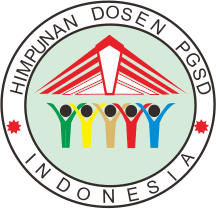Penerapan model creative problem solving (CPS) untuk meningkatkan keterampilan pemecahan masalah matematika soal cerita bangun datar pada siswa kelas v SD
Abstract
Keywords
Full Text:
PDFReferences
F. &. Durrotunnisa, Keterampilan Abad 21 dalam Pendidikan. Surabaya: XYZ, 2020. [2] A. Robbani, “Pentingnya Matematika dalam Era Digital,” J. Pendidik. Mat., vol. 12, no. 3, pp. 186–192, 2023. [3] R. A. Juwantara, “Analisis Teori Perkembangan Kognitif Piaget Pada Tahap Anak Usia Operasional Konkret 7-12 Tahun dalam Pembelajaran Matematika,” Al-Adzka J. Ilm. Pendidik. Guru Madrasah Ibtidaiyah., 2019. [4] A. Shoimin, Pembelajaran Inovatif di Abad 21. Yogyakarta: Yogyakarta: Ar-Ruzz Media, 2016. [5] M. Huda, Model-Model Pengajaran dan Pembelajaran. Yogyakarta: Pustaka Pelajar, 2013. [6] D. Purnamasari, “engaruh Model CPS terhadap Kemampuan Pemecahan Masalah,” J. Penelit. Pendidik., vol. 8, no. 2, pp. 87–95, 2016. [7] L. e. Kashani-Vahid, “Creative Problem Solving in Elementary Education,” Educ. Res. J., vol. 14, no. 1, pp. 45–59, 2017. [8] D. J. Treffinger, Creative Problem Solving: An Introduction (4th ed.). Waco, TX: Prufrock Press., 2006. [9] G. J. Puccio, “Current developments in Creative Problem Solving for organizations: A focus on thinking skills and styles. The Korean Journal of Thinking & Problem Solving,” vol. 17, no. 2, pp. 7–26, 2007. [10] S. G. Isaksen, Creative Approaches to Problem Solving: A Framework for Innovation and Change (3rd ed.). Thousand Oaks, CA: SAGE Publications, 2011. [11] A. J. Cropley, Creativity in Education and Learning: A Guide for Teachers and Educators. London: Routledge, 2015. [12] M. Basadur, Design-Centered Entrepreneurship: How to Use Creative Problem Solving for Innovation and Change. London: Bloomsbury Academic, 2021. [13] A. M. Fardah, “Pengaruh Model Pembelajaran Creative Problem Solving terhadap Kemampuan Berpikir Kreatif Siswa,” J. Pendidik. dan Pembelajaran, vol. 27, no. 3, pp. 123–130, 2020. [14] T. Anderson, A Taxonomy for Learning, Teaching, and Assessing: A Revision of Bloom’s Taxonomy of Educational Objectives. New York: Longman, 2001. [15] C. Hendricks, Improving Schools Through Action Research: A Reflective Practice Approach (4th ed.). Boston, MA: Pearson, 2017. [16] R. Sagor, The Action Research Guidebook: A Four-Step Process for Educators and School Teams (3rd ed.). Thousand Oaks, CA: Corwin Press, 2020.
Refbacks
- There are currently no refbacks.



